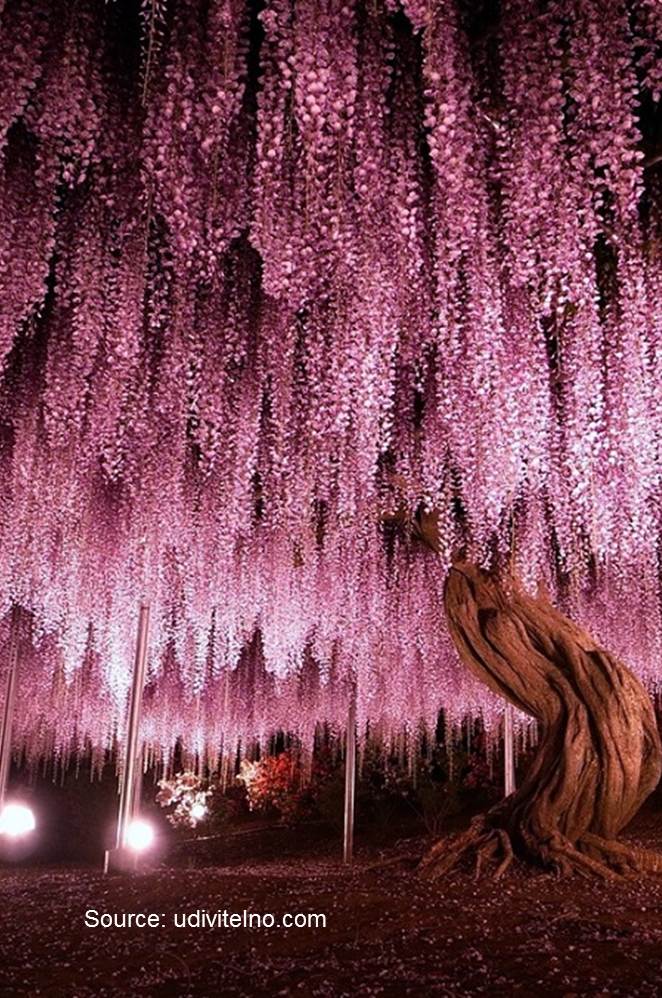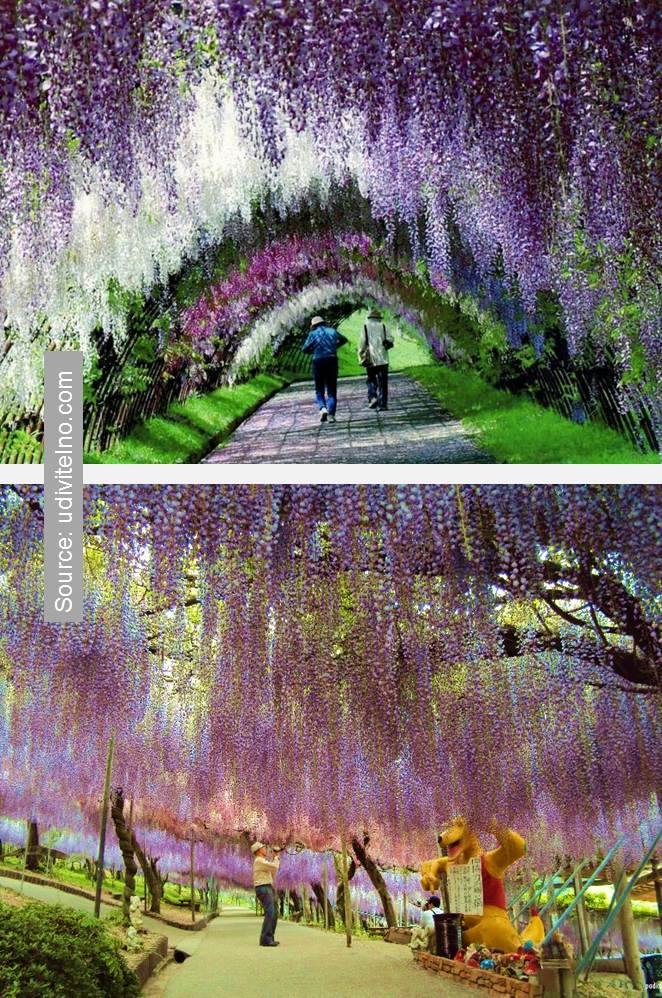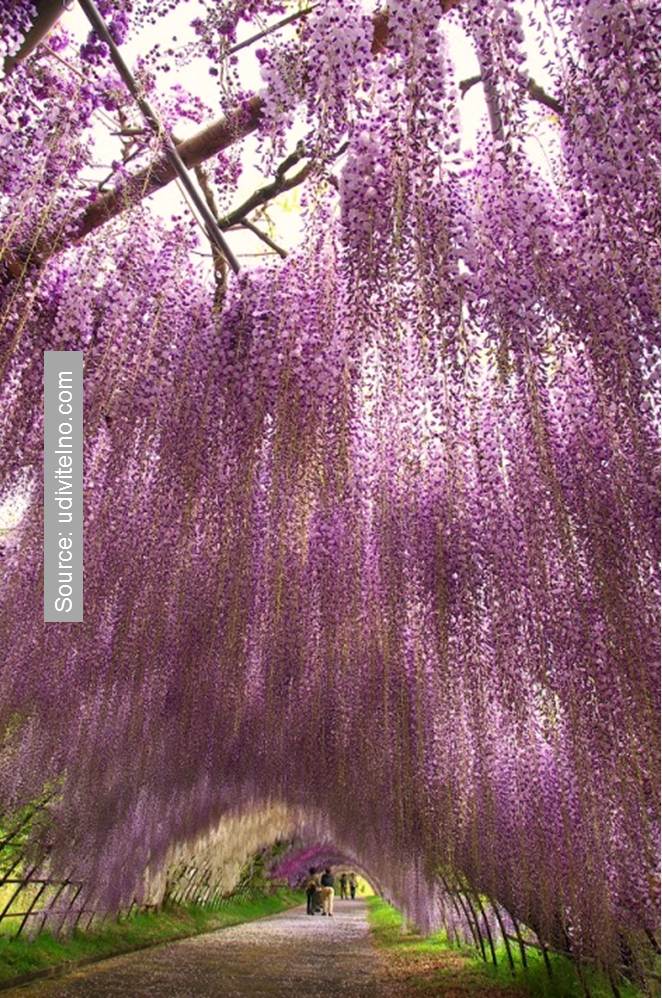Nothing rivals the beauty of a wisteria arbour in full bloom. It’s a surreal and stunning beauty. The flower clusters hang down for the tip of the plant’s long vines and sway beautifully in the wind.
Wisteria is the queen of garden vines and is widely used to decorate the site and buildings. Appearing before the leaves in late spring to early summer, wisteria blooms repeatedly during the whole summer.
Wisteria – what’s in the name?
The botanist Thomas Nuttall said he named the genus Wisteria in memory of the American physician and anatomist Caspar Wistar. The wisteria is often called Glycine that in Greek means “sweet”.
Only Latin countries such as Italy, Spain, and France have kept the name “Glycine”. However, the Germans made up a beautiful name, “Blaue regan” which means “Blue rain”.
Those names seem too many for one plant alone but each name has its own story to tell.
Description
There was a lot of controversy as to whether it was a flower or a liana. However, as a result, the general concept was formed that wisteria is a tree-like climbing and flowering plant. So, botanically, wisteria is a genus of flowering plants in the legume family, Fabaceae, that includes ten species of woody climbing vines that are native to China, Korea, Japan, and the Eastern United States.
In appearance, wisteria a woody liana with drooping branches. An adult wisteria can reach 15-18m in height, and the crown sometimes grows up to 8m in diameter. It’s not very fast growth – during the season it can grow by only 20cm.
Wisteria blooms with pink, lavender, purple, blue and white flowers, which are collected in loose clusters up to 30cm in length. Flowering of this amazing liana begins in spring in late March or early April and lasts almost until the end of the summer. Wisteria flowers have a delicious aroma.
Wisteria legends
There is a wonderful Chinese legend about the origin of wisteria. Once upon a time, a beautiful girl named Gui lived in a small village. Her beauty was so stunning that no one could take their eyes off her. Her hair shimmered with lilac-violet shades during the day, and became bluish in the evening. A dragon fell in love with her and kidnapped the girl. And after such a terrible crime, the dragon was turned into a tree entwining other plants. And when the dragon raised its head, trying to release the flame, only flowers appeared, resembling the hair of that beautiful girl. Nobody knew what happened to the girl.
Another legend says that one day, while she was crying her tears fell on the ground and generated a wonderful fragrant plant, the wisteria. And who knows what happened to the dragon.
Wisteria flowers symbolism
In Japan
Wisteria is a plant that grows all over Japan and which has captivated Japanese people for a long time.
Historically, wisteria symbolizes long-life and immortality. Wisteria has been widely used in Japan throughout the centuries and was a popular symbol in family crests and heraldry.
One popular dance in kabuki, “The Wisteria Maiden” is the sole extant dance of a series of five personifying dances, in which a maiden becomes the embodiment of the spirit of wisteria. In Japanese Kabuki Theater, the symbolism for the wisteria is love, sensuality, support, sensitivity, bliss, and tenderness.
The abundance of the Wisteria flowering vine also signifies our own expanding consciousness.
Japanese largest wisteria plant
According to Wikipedia, the largest wisteria in Japan (more likely – in the world) blossoms at Ashikaga Flower Park in Ashikaga, Tochigi, Japan. It is dated to c. 1870 and covered approximately 1,990 square metres. Thousands of tourists gather to admire the surreal beauty of this tree-like liana.
Wisteria tunnels in the Kawachi Fujien garden
At Kawachi Fujien in Kitakyushu City, the northernmost city on Japan’s Kyushu Island, you can enjoy the grand sight of these beautiful wisteria flowers. It’s a private wisteria garden established in 1977 which is open only during wisteria season. Approximately 150 trees (lots of them are more than 100 years old) comprising 22 types of wisteria in a variety of colours grow in a 10,000 sq. m area.
There are two wisteria tunnels: the 80m long and a 220m long. Wisteria tunnels became extremely popular after they were introduced on a website in 2012 and have become a tourist attraction for visitors from all over the world. There are huge wisteria trellises at the end of the tunnels and you can see wisteria trees which.
In China
In China, wisteria is commonly featured in art and plays involving marriage. Many people exchange the flowers as a good luck charm when planning a wedding. Since the vines and trees bloom in spring and early summer, it’s a potent symbol of new life.
Cultivation
The beauty of a wisteria in full bloom is a dream of many gardeners, but, unfortunately, successfully growing these lovely vines is a hard and tricky job.
Wisteria can grow into a mound when unsupported, but is at its best when allowed to clamber up a tree, pergola, wall, or other supporting structure.
Wisteria specimens grown from seed can take decades to bloom; for this reason, gardeners usually grow plants that have been started from rooted cuttings or grafted cultivars known to flower well
Enjoy the pictures!












































